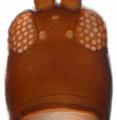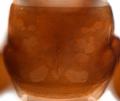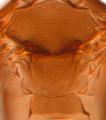Aeolothrips fuscus
Recognition data
Distinguishing features
Both sexes fully winged. Body and legs uniformly brown; female with antennal segment III brownish yellow and brown in apical third, segments II and IV brown; forewings with posterior margin dark except for base and apex, this dark area not extending to anterior longitudinal vein and with no transverse dark band. Head with no long setae; pronotal posteromarginal setae not stouter than pronotal discal setae. Fore tarsus apically with stout recurved ventral hamus. Antennae 9-segmented, sensorium on segment III and IV about 0.4 as long as segment, V–IX forming a single unit with V longer than VI–IX. Metanotum with equiangular reticulation medially. Marginal setae on sternites arising at or close to margin; sternite VII supernumerary paired setae arising well in front of margin.
Male without paired tubercles on tergites IV–V; tergite IX with bifurcate clasper but without a stout curved seta laterally; antennal segment III fuscous not yellow, in contrast to the female.
Related and similar species
A. fuscus is a member of a species-complex in which the fore wing bears a longitudinal dark area along the posterior margin. Most of these species are from North America. A. kuwanaii is particularly similar in the females, although the males lack a stout seta lateral to the claspers. Just over 90 species are placed currently in the genus Aeolothrips, of which more than 50 are from the Palaearctic Region (mainly Europe), and 28 from the Nearctic (mainly western USA). Only two species are recorded from the Neotropics; the one from Chile is probably the same as A. fasciatus, and one from Panama is probably not a member of this genus (Mound & Marullo, 1996).
Taxonomic data
Current valid name
Aeolothrips fuscus Watson
Original name and synonyms
- Aeolothrips fuscus Watson, 1931: 340
Family placement
Aeolothripidae
Biological data
Life history
Presumably a facultative predator in flowers, with a mixed diet of pollen and the larvae of other thrips.
Host plants
Swept from various plants, with no information on any specificity.
Tospoviruses vectored
None
Crop damage
None
Distribution data
Area of origin
USA
Distribution
Oklahoma, California, Arizona, Nevada, and Utah.








